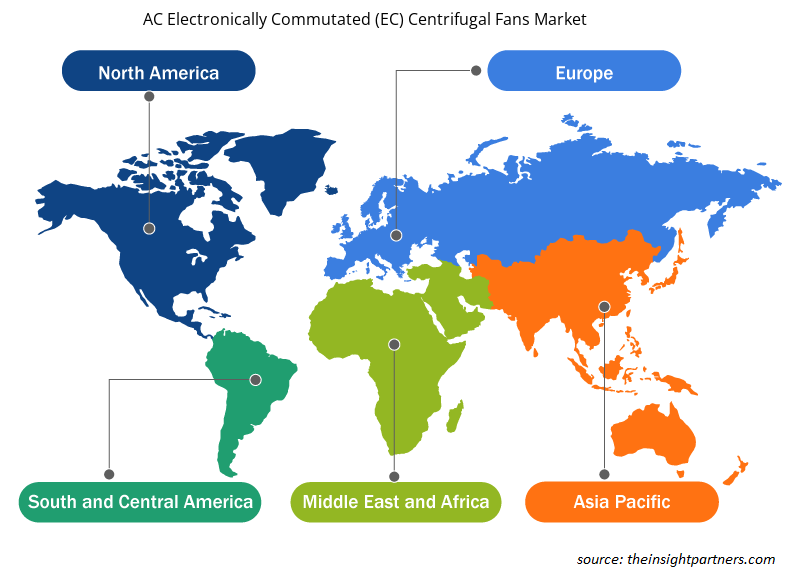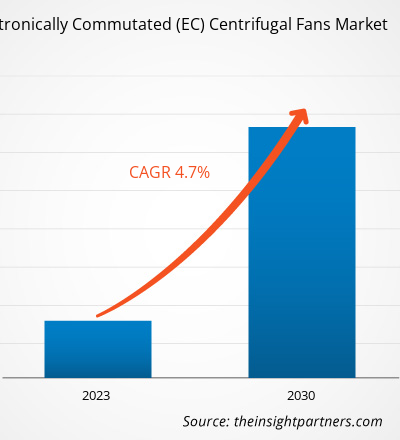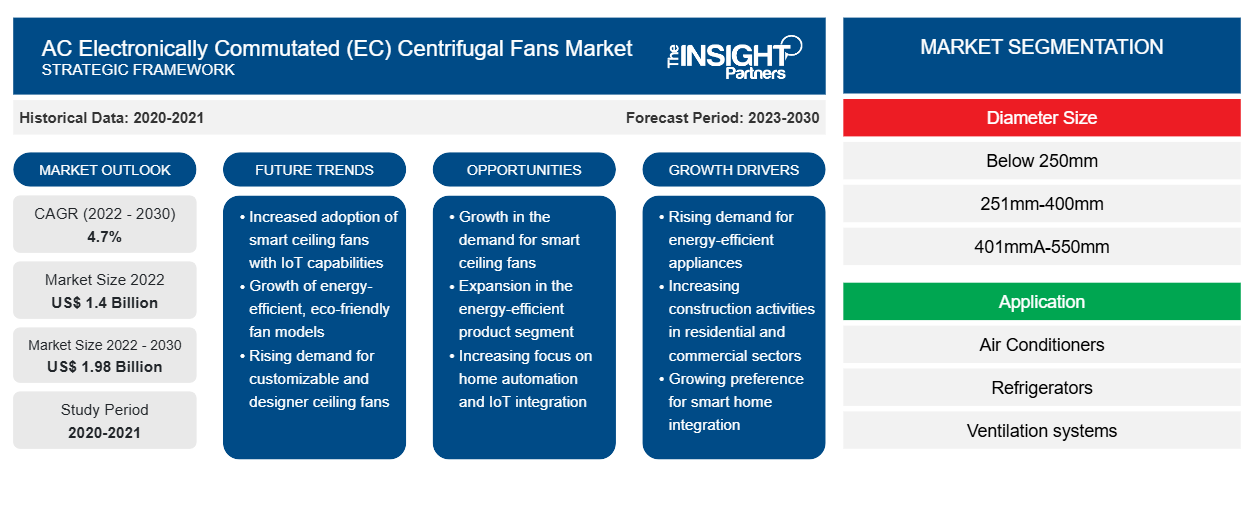[Forschungsbericht] Der Markt für elektronisch kommutierte (EC) AC-Radialventilatoren soll von 1.403,06 Millionen US-Dollar im Jahr 2022 auf 1.979,65 Millionen US-Dollar im Jahr 2030 wachsen; von 2023 bis 2030 wird eine durchschnittliche jährliche Wachstumsrate (CAGR) von 4,7 % erwartet .
Perspektive eines Marktanalysten für elektronisch kommutierte (EC) AC-Radialventilatoren:
Die elektronisch kommutierte (EC) Technologie kombiniert Wechsel- und Gleichspannungen, um das gewünschte Ergebnis zu erzielen. Der EC läuft mit Gleichspannung mit einphasigem 230 V oder dreiphasigem 400 V Wechselstrom. Der nicht rotierende Teil von EC-Motoren ist verlängert, um Platz für eine elektronische Leiterplatte (PCB) zu schaffen, die die Umwandlung von Wechselstrom in Gleichstrom und Steuerungen enthält. Die EC-Elektronik unterscheidet sich von Frequenzumrichtern und entscheidet je nach Position, Drehrichtung und Vorgabe, wie die Motorphasen des Stators mit Strom versorgt werden (Kommutierung). EC-Motoren ( ECMs ) benötigen eine individuelle Gleichstromversorgung, was zu zusätzlichen Kosten und Komplexität in den Anwendungen führt. EC-Lüfter mit integrierter Elektronik, die direkt am Wechselstromnetz betrieben werden konnten, waren Anfang der 2000er Jahre erhältlich. Die Elektronik in EC-Lüftern wandelte Wechselstrom in Gleichstrom um, führte die Kommutierung durch und regulierte die Lüftergeschwindigkeit, indem sie die Motorleistung steuerte, in der Regel mit Pulsweitenmodulation ( PWM ).
Marktübersicht für elektronisch kommutierte (EC) AC-Radialventilatoren:
Verschiedene Länder der Welt konzentrieren sich auf Energieeinsparungen durch die Umsetzung unterschiedlicher Strategien. Das US-Energieministerium (DOE) hat bestätigt, dass Komponenten in Geräten und Anlagen sowie elektromotorbetriebene Systeme etwa 25 % des Primärenergieverbrauchs im Wohn- und Gewerbebereich ausmachen. Der Ersatz aktueller Geräte durch innovative energieeffiziente Motoren führt zu einer erheblichen Kosten- und Energieverbrauchssenkung. EC-Lüfter ermöglichen erhebliche Energieeinsparungen und bieten Luftstrom- und Kühllösungen für Anwendungen mit höheren Anforderungen an die elektrische Effizienz. Dieser Faktor wird voraussichtlich den globalen Markt für elektronisch kommutierte (EC) AC -Radialventilatoren im Prognosezeitraum ankurbeln.
Passen Sie diesen Bericht Ihren Anforderungen an
Sie erhalten kostenlos individuelle Anpassungen an jedem Bericht, einschließlich Teilen dieses Berichts oder einer Analyse auf Länderebene, eines Excel-Datenpakets sowie tolle Angebote und Rabatte für Start-ups und Universitäten.
-
Holen Sie sich die wichtigsten Markttrends aus diesem Bericht.Dieses KOSTENLOSE Beispiel umfasst eine Datenanalyse von Markttrends bis hin zu Schätzungen und Prognosen.
Marktbeschränkung für elektronisch kommutierte (EC) AC-Radialventilatoren:
Zunehmender Einsatz intelligenter synchroner Permanentmagnetmotoren schränkt das Wachstum des Marktes für elektronisch kommutierte AC- Radialventilatoren (EC) ein
Intelligente synchrone Permanentmagnetmotoren ( SSPMMs ) verbrauchen weniger Energie und sind effizienter. Synchronmotoren werden in Roboterantrieben, Kugelmühlen, Uhren, Plattenspielern und Plattentellern verwendet. Die intelligenten synchronen Permanentmagnetmotoren helfen dabei, den Energieumwandlungsprozess nach dem Start des Motors zu überspringen, was zu Energieeinsparungen und Effizienzsteigerungen führt. SSPMMs machen den Einsatz von Elektronik überflüssig und verwenden eine Spule für etwaige Spannungsspitzen. Darüber hinaus senken die höhere Effizienz und der geringere Leistungsverlust des SSPMM die Betriebstemperatur und erhöhen die erwartete Lebensdauer.
Darüber hinaus bedient der Markt für intelligente synchrone Permanentmagnetmotoren oft unterschiedliche Segmente und Anwendungen. Intelligente synchrone Permanentmagnetmotoren finden Anwendung in verschiedenen Branchen, darunter Automobilindustrie, Robotik und Industriemaschinen, wo Hochleistungsmotoren benötigt werden. Außerdem eignen sich SSPMMs hervorragend für bestimmte Anwendungen, bei denen ein hohes Drehmoment und eine hohe Leistungsdichte unerlässlich sind. Daher hemmt der zunehmende Einsatz von SSPMMs das Marktwachstum für elektronisch kommutierte (EC) AC-Radialventilatoren.
Marktsegmentanalyse für elektronisch kommutierte AC- Radialventilatoren (EC) :
Basierend auf der Anwendung wurde der Markt für elektronisch kommutierte (EC) AC-Radialventilatoren in Klimaanlagen, Kühlschränke, Lüftungssysteme, elektronische Schaltschränke und andere unterteilt. Das Segment der Klimaanlagen wird voraussichtlich im Jahr 2023 den größten Marktanteil an elektronisch kommutierten (EC) AC-Radialventilatoren haben. Klimaanlagen bieten eine höhere Geschwindigkeit, da kältere Luft dichter ist. Die Klimatechnik auf dem Markt zeichnet sich durch drei Hauptanforderungen aus: Energieeffizienz, Steuerbarkeit für eine gute Lastanpassung und Anpassungsfähigkeit an eine breite Palette von Kundenanforderungen. Der EC-Motor läuft auch unter Teillastbedingungen leise und effizient. Alle in der gesamten Klimabranche erforderlichen Lüftersteuerungen, Programmierungen und Überwachungen sind über die integrierte Motorelektronik verfügbar, die über Software bedient und sogar drahtlos abgerufen werden kann .
Regionale Analyse des Marktes für elektronisch kommutierte (EC) AC-Radialventilatoren:
Der globale Markt für elektronisch kommutierte AC-Radialventilatoren (EC) ist in fünf große Regionen unterteilt: Nordamerika, Europa, APAC, MEA und SAM. Europa war im Jahr 2022 Marktführer und wird voraussichtlich im Prognosezeitraum den Marktanteil für elektronisch kommutierte AC-Radialventilatoren (EC) dominieren. Mehrere Branchen in APAC und Nordamerika verlagern ihre Schwerindustrieanlagen nach Europa, um ihre Gewinnmargen zu steigern. Das Wachstum des Marktes für elektronisch kommutierte AC-Radialventilatoren (EC) in APAC ist hauptsächlich auf die zunehmende Neigung zu Stromeinsparungen in verschiedenen Ländern der Region zurückzuführen. Darüber hinaus sind EC-Ventilatoren eine bevorzugte Wahl, um Energieeffizienz in Motoren zu erreichen. EC-Ventilatoren und -Motoren, die der europäischen Norm EN 60335-2-89 entsprechen, sind die bevorzugte Wahl mehrerer Hersteller gewerblicher Kältetechnik für Anwendungen, bei denen brennbare Kältemittel wie R290 (Propan) verwendet werden. Viele Elektronikunternehmen in Europa ersetzen vorhandene Ventilatoren durch EC-Ventilatoren aufgrund ihrer Effizienz, Steuerbarkeit und Kosteneinsparung. Verschiedene Unternehmen, die elektronisch kommutierte (EC) Lüfter anbieten, haben Akquisitionen und Fusionen als Schlüsselstrategie gewählt, um ihre geografische Präsenz zu vergrößern und ihre Produkttechnologien weiterzuentwickeln. Im Mai 2019 fusionierte IKOR, ein in Spanien ansässiger Hersteller von Lüftern und Motoren, mit der Ebm-Papst-Gruppe. Die Ebm-Papst-Gruppe mit Sitz in Mulfingen, Deutschland, beschäftigt 15.000 Mitarbeiter, verfügt über 48 Tochtergesellschaften und Vertriebsbüros sowie 27 Produktionsstandorte. Das Unternehmen bietet Motoren und Lüfter für Haushaltsgeräte, Lüftung und Telekommunikation an. Dieser Schritt wird dazu beitragen, die nachhaltige Wachstumsstrategie von IKOR in allen Märkten der Ebm-Papst-Gruppe voranzutreiben.
Marktanalyse der wichtigsten Akteure für elektronisch kommutierte AC-Radialventilatoren (EC):
Die Marktanalyse für elektronisch kommutierte (EC) Wechselstrom-Radialventilatoren umfasst Akteure wie Rosenberg Ventilatoren GmbH; Ebm-papst; Delta Electronics; Ziehl-Abegg; Airtècnics; Hidria.; PBM Motor and Fan (Suzhou) Co Ltd., Ltd.; Simx Ltd.; Shipox Inc; Regal Rexnord Corp; und Continental Fan sind aufgrund ihres diversifizierten Produktportfolios die beiden größten Akteure.
Elektronisch kommutierte AC-Radialventilatoren
Regionale Einblicke in den Markt für elektronisch kommutierte AC-Radialventilatoren (EC)
Die regionalen Trends und Faktoren, die den Markt für elektronisch kommutierte AC-Radialventilatoren (EC) während des gesamten Prognosezeitraums beeinflussen, wurden von den Analysten von Insight Partners ausführlich erläutert. In diesem Abschnitt werden auch die Marktsegmente und die Geografie für elektronisch kommutierte AC-Radialventilatoren (EC) in Nordamerika, Europa, im asiatisch-pazifischen Raum, im Nahen Osten und Afrika sowie in Süd- und Mittelamerika erörtert.

- Erhalten Sie regionale Daten zum Markt für elektronisch kommutierte AC-Radialventilatoren (EC).
Umfang des Marktberichts für elektronisch kommutierte AC-Radialventilatoren (EC)
| Berichtsattribut | Details |
|---|---|
| Marktgröße im Jahr 2022 | 1,4 Milliarden US-Dollar |
| Marktgröße bis 2030 | 1,98 Milliarden US-Dollar |
| Globale CAGR (2022 - 2030) | 4,7 % |
| Historische Daten | 2020-2021 |
| Prognosezeitraum | 2023–2030 |
| Abgedeckte Segmente |
Nach Durchmessergröße
|
| Abgedeckte Regionen und Länder |
Nordamerika
|
| Marktführer und wichtige Unternehmensprofile |
|
Marktteilnehmerdichte für elektronisch kommutierte (EC) AC-Radialventilatoren: Auswirkungen auf die Geschäftsdynamik verstehen
Der Markt für elektronisch kommutierte AC-Radialventilatoren (EC) wächst rasant. Dies wird durch die steigende Nachfrage der Endnutzer aufgrund von Faktoren wie sich entwickelnden Verbraucherpräferenzen, technologischen Fortschritten und einem größeren Bewusstsein für die Vorteile des Produkts vorangetrieben. Mit der steigenden Nachfrage erweitern Unternehmen ihr Angebot, entwickeln Innovationen, um die Bedürfnisse der Verbraucher zu erfüllen, und nutzen neue Trends, was das Marktwachstum weiter ankurbelt.
Die Marktteilnehmerdichte bezieht sich auf die Verteilung der Firmen oder Unternehmen, die in einem bestimmten Markt oder einer bestimmten Branche tätig sind. Sie gibt an, wie viele Wettbewerber (Marktteilnehmer) in einem bestimmten Marktraum im Verhältnis zu seiner Größe oder seinem gesamten Marktwert präsent sind.
Die wichtigsten Unternehmen auf dem Markt für elektronisch kommutierte (EC) AC-Radialventilatoren sind:
- Delta Electronics Inc
- Ziehl-Abegg UK Ltd
- Hidria
- ebm-papst
- Kontinentaler Fan
Haftungsausschluss : Die oben aufgeführten Unternehmen sind nicht in einer bestimmten Reihenfolge aufgeführt.

- Erhalten Sie einen Überblick über die wichtigsten Akteure auf dem Markt für elektronisch kommutierte AC- Radialventilatoren (EC)
Aktuelle Entwicklungen auf dem Markt für elektronisch kommutierte (EC) AC-Radialventilatoren:
Anorganische und organische Strategien wie Fusionen und Übernahmen werden von Unternehmen auf dem Markt für elektronisch kommutierte (EC) Wechselstrom-Radialventilatoren häufig eingesetzt. Nachfolgend sind einige aktuelle wichtige Marktentwicklungen aufgeführt:
- Im Jahr 2020 kündigte Regal Rexonard Corporation die Einführung von Regal Perceptiv Intelligence an. Regal Perceptiv Intelligence ist eine neue Art der Nutzung und Interaktion mit Regal-Produkten und -Diensten. Es handelt sich um Hardware, Software und „ Humanware “. Perceptiv Intelligence ist eine vernetzte Matrix intelligenter, digitaler Lösungen, die das Potenzial haben, Kunden bei der Zusammenarbeit mit Regal zu unterstützen, die Zuverlässigkeit der Geräte und die Anlagenproduktion zu maximieren.
- Im Jahr 2019 brachte Rosenberg Ventilatoren GmbH einen neuen EC-Motor der Generation 3 auf den Markt, der 30 % leistungsstärker ist als die Generation 2. Die Integration des neuen EC-Motors beginnt mit Freilaufrädern, Axialventilatoren, Radialventilatoren und dem ECFanGrid . Er wird voraussichtlich den Motor der Generation 2 in Standardventilatoren wie Dach-, Kasten- und Kanalventilatoren ersetzen.
- Historische Analyse (2 Jahre), Basisjahr, Prognose (7 Jahre) mit CAGR
- PEST- und SWOT-Analyse
- Marktgröße Wert/Volumen – Global, Regional, Land
- Branchen- und Wettbewerbslandschaft
- Excel-Datensatz
Aktuelle Berichte
Erfahrungsberichte
Grund zum Kauf
- Fundierte Entscheidungsfindung
- Marktdynamik verstehen
- Wettbewerbsanalyse
- Kundeneinblicke
- Marktprognosen
- Risikominimierung
- Strategische Planung
- Investitionsbegründung
- Identifizierung neuer Märkte
- Verbesserung von Marketingstrategien
- Steigerung der Betriebseffizienz
- Anpassung an regulatorische Trends























 Kostenlose Probe anfordern für - Markt für elektronisch kommutierte AC-Radialventilatoren (EC)
Kostenlose Probe anfordern für - Markt für elektronisch kommutierte AC-Radialventilatoren (EC)